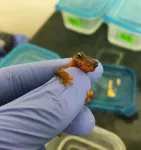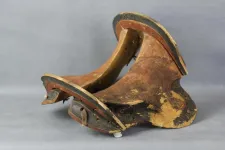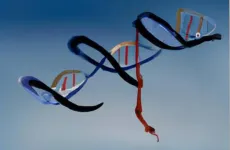(Press-News.org) MADISON – An interdisciplinary team led by University of Wisconsin–Madison scientists has developed a new technique that could help farmers extract useful nutrients such as ammonia and potassium from livestock manure to efficiently make fertilizer and other useful chemical products. While the strategy still needs to be scaled up beyond a proof-of-concept stage, the group's preliminary analyses show it could offer considerable benefits by cutting water and air pollution while simultaneously creating products that farmers could use or sell.
Manure stinks in part because it contains ammonia, one of the more than 300 compounds that contribute to its odor. The pungent gas is not only a harmful air pollutant but can turn into the greenhouse gas nitrous oxide and water-polluting nitrate.
Ammonia is also the foundation of many nitrogen fertilizers that have fueled modern crop production. The industrial method for making ammonia for nitrogen-based fertilizers, the Haber-Bosch process, consumes a lot of energy and emits hundreds of millions of tons of greenhouse gasses every year.
Although manure itself can be used as fertilizer, doing so can be costly, logistically challenging and has environmental drawbacks. So, researchers around the world are hunting for strategies to efficiently recover ammonia from manure, creating more concentrated and valuable fertilizers that are greener and more affordable to transport.
Among these strategies are chemical processes driven by electricity, which is becoming increasingly inexpensive in many rural communities thanks to growing solar and wind power generation. However, most electrochemical techniques in development are not yet practical, mainly because they consume a lot of energy and aren’t efficient enough at pulling dissolved ammonia (in the form of ammonium ions) out of manure.
This new technique, described in a Dec. 8 paper published in the journal Nature Sustainability, relies on a specially designed electrode, like those used for batteries, that targets ammonium ions.
The technique involves a nickel-based electrode that is placed directly into the manure wastewater. As organic matter in the manure naturally gets oxidized by the electrode, the ammonium, as well as potassium ions, within the wastewater are selectively driven into and captured by the electrode.
The strategy does not end with simply removing the nutrients from the wastewater.
In an innovative step that could help make the process even more attractive, the nutrient-loaded electrode is then placed into a device that uses electricity to release the recovered ammonium and potassium ions, which can then be used to make nitrogen and potassium-based fertilizers, and simultaneously produce other useful chemical products. These could include hydrogen fuel or hydrogen peroxide, which is commonly used for disinfection.
"We got lucky because nature does a lot of the work for us," says Song Jin, a UW–Madison professor of chemistry who led the work along with doctoral candidate Rui Wang and civil and environmental engineering Professor Mohan Qin.
"Manure has all this stuff in it and we don't have to do too much extra work," Jin says. "The battery material goes in, and ammonia gets sucked out when the organic stuff gets oxidized."
Trial runs with small amounts of manure recovered more than half the ammonia in the first pass, with a recovery of about 85% after two cycles.
The ability to produce fertilizers and other chemical products together is a key part of why the team believe their strategy could be a winner. An environmental analysis led by Rebecca Larson, a professor in the Nelson institute for Environmental Studies, indicates that a 1,000-head dairy farm operation could reduce its ammonia emissions by more than 50% by deploying the system, while also significantly reducing the amount of nitrate entering nearby waters.
Meanwhile, a preliminary technical economic analysis led by Professor Fikile Brushett, a collaborator at Massachusetts Institute of Technology, shows that a model dairy farm using the system could expect resulting revenues to be higher than operating costs, so long as electricity prices aren't exorbitant.
The next steps include further improving the materials and processes, scaling the system up and studying how it functions at a level more closely resembling a real-world livestock operation. Jin is optimistic that the system's benefits will continue to outweigh potential costs at these larger scales, given the initial analyses.
"It looks indeed to be promising," says Qin. "There's a pathway to see how this might really help in the real world."
This research was supported by the National Science Foundation (NSF, CBET- 2219089). A provisional patent on this technology has also been filed by the Wisconsin Alumni Research Foundation (WARF).
# # #
--Will Cushman, wcushman@wisc.edu, 608-263-1986
END
DENVER/Dec. 12, 2023 – A new article published in the journal Methods in Ecology and Evolution by Morris Animal Foundation-funded researchers describes a simplified method to detect a deadly fungus killing European salamanders. The ability to rapidly find the fungus is significant as the disease, although not detected in the U.S., could impact the millions of amphibians and salamanders annually imported.
The fungal pathogen Batrachochytrium salamandrivorans, or Bsal, threatens salamander diversity. Initially identified in northern Europe, evidence suggests it was introduced from Southeast Asia via the pet trade.
“The impacts of Bsal ...
EMBO launches a new award for laboratory sustainability: The EMBO Lab Sustainability Award will recognize new and significant contributions to the development of sustainable wet and dry labs with a focus on their environmental impact. The award will be presented to an individual representing the initiative or project. Applications can be submitted between 15 January and 15 March 2024.
The award winner will have the opportunity to present their initiative or project at scientific events and publish a commentary in EMBO Reports. In addition, the winning project will be supported with a grant of 10,000 euros. The award is one of ...
ROCHESTER, Minn. — Stem cell-based therapy improved quality of life for patients with advanced heart failure, Mayo Clinic researchers and international collaborators discovered in a late-stage multinational clinical trial. In one of the largest studies of cell intervention after a heart attack, patients reported their daily hardship lessened when stem cells optimized for heart repair supplemented standard of care. This clinical study further documented lower death and hospitalization rates among those treated with cell therapy. This research ...
ABSTRACT: LBA-2
SAN DIEGO ― The targeted therapy combination of ibrutinib and venetoclax significantly improved progression-free survival (PFS) and achieved an overall remission rate in 82% of patients with relapsed/refractory mantle cell lymphoma (MCL), according to researchers at The University of Texas MD Anderson Cancer Center. Results from the Phase III SYMPATICO trial were presented at the 2023 American Society of Hematology (ASH) Annual Meeting.
At a median follow-up of 51.2 months, median PFS was 31.9 months with the combination compared to 22.1 months with ibrutinib plus placebo. PFS benefits were consistent across patient subgroups, including those with blastoid-variant ...
DURHAM, N.C. – Identifying an older patient who is at risk for post-operative cognitive dysfunction might be done in the blink of an eye – literally.
Researchers at Duke Health found that a simple EEG measurement detects a signal of cognitive vulnerability when patients are asked to close, then open their eyes. Conducted prior to surgery, the non-invasive readout of brain waves helps predict which patients are at risk of post-operative confusion and attention problems.
“Roughly half of seemingly normal older adults experience problems with thinking, memory or attention after surgery,” said Leah Acker, M.D., Ph.D., assistant professor in ...
In April 2015, looters sacked an ancient cave burial at a site called Urd Ulaan Uneet high within the Altai Mountains of western Mongolia. When police apprehended the criminals, they uncovered, among other artifacts, an elegantly carved saddle made from several pieces of birch wood.
Now, in a new study, researchers from Mongolia collaborating with University of Colorado Boulder archaeologist William Taylor have described the find. The team’s radiocarbon dating pins the artifact to roughly the 4th Century ...
UNIVERSITY PARK, Pa. — Self-propelled nanoparticles could potentially advance drug delivery and lab-on-a-chip systems — but they are prone to go rogue with random, directionless movements. Now, an international team of researchers has developed an approach to rein in the synthetic particles.
Led by Igor Aronson, the Dorothy Foehr Huck and J. Lloyd Huck Chair Professor of Biomedical Engineering, Chemistry and Mathematics at Penn State, the team redesigned the nanoparticles into a propeller shape to better control their movements and increase their functionality. ...
Karandeep Singh, MD, has been recruited as the Joan and Irwin Jacobs Endowed Chair in Digital Health Innovation at University of California School of Medicine and named as the inaugural chief health artificial intelligence (AI) officer at UC San Diego Health, a newly developed position for the region’s only academic medical center.
This new role will be effective December 29, 2023.
In this position, Singh will focus on implementing change that advances safety and health outcomes in acute and ambulatory settings. His contributions will be pivotal in bringing innovation to ...
NEW YORK, NY--Many Black Americans who are thought to have a high risk of developing kidney disease possess a protective genetic variant that nullifies the extra risk, a new study from Columbia researchers has found.
The study found that high-risk people who carry this variant have a risk of developing kidney disease much closer to that of the general population.
The findings will have an immediate impact on clinical practice, says study leader Simone Sanna-Cherchi, MD, associate professor of medicine at Columbia’s Vagelos College of Physicians and Surgeons.
“Physicians ...
FOR IMMEDIATE RELEASE
Using a “liquid biopsy” to study genetic material from tumors shed into the bloodstream together with immune cells could help clinicians predict which patients with advanced lung cancers are responding to immunotherapies and which patients may develop immune-related side effects several months later, according to research directed by investigators at the Johns Hopkins Kimmel Cancer Center, the Bloomberg~Kimmel Institute for Cancer Immunotherapy and Allegheny Health Network Cancer Institute in Pittsburgh.
By monitoring changes in circulating tumor DNA (ctDNA) among 30 patients treated with immunotherapies for metastatic non-small cell lung cancers, ...




